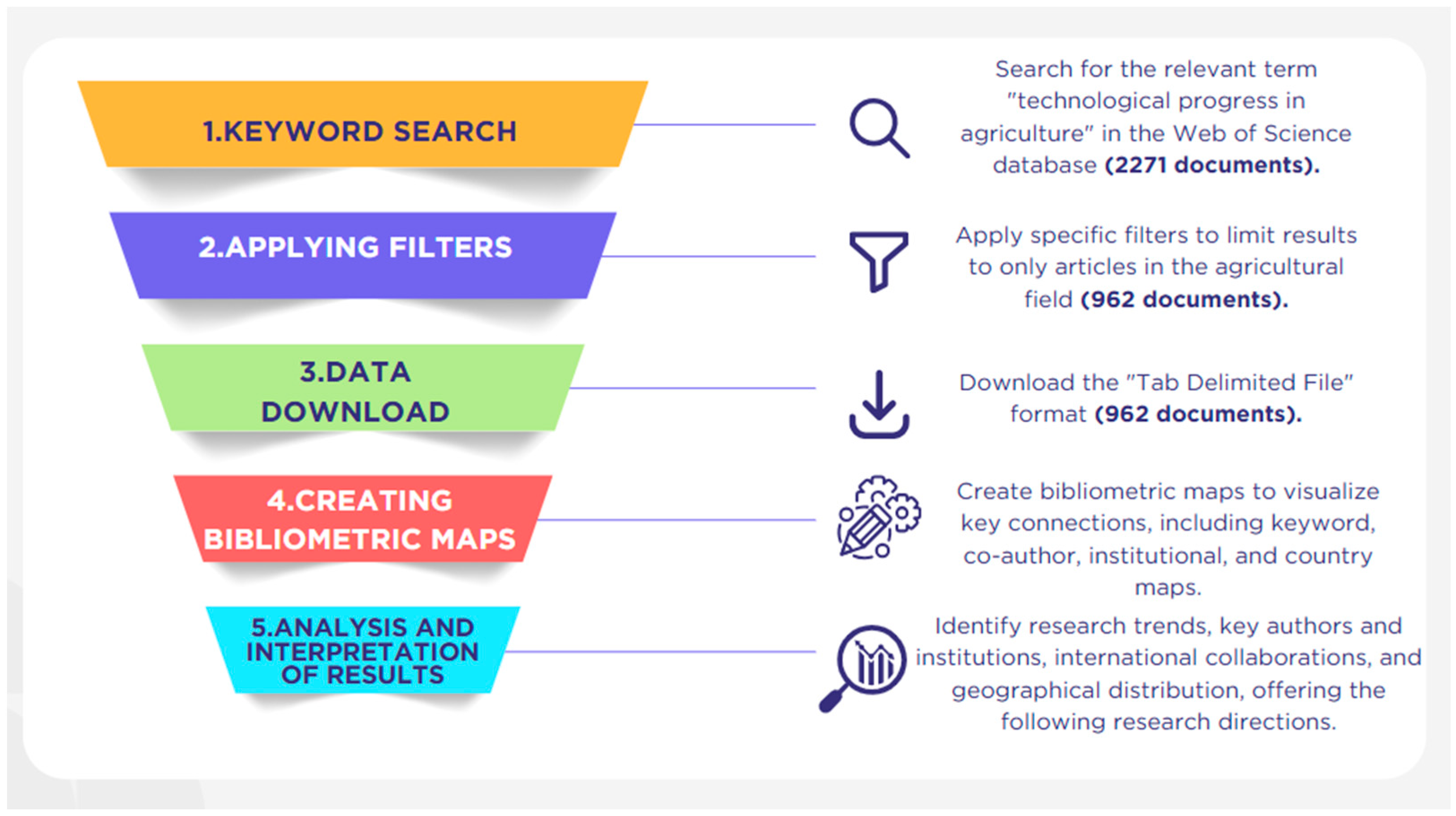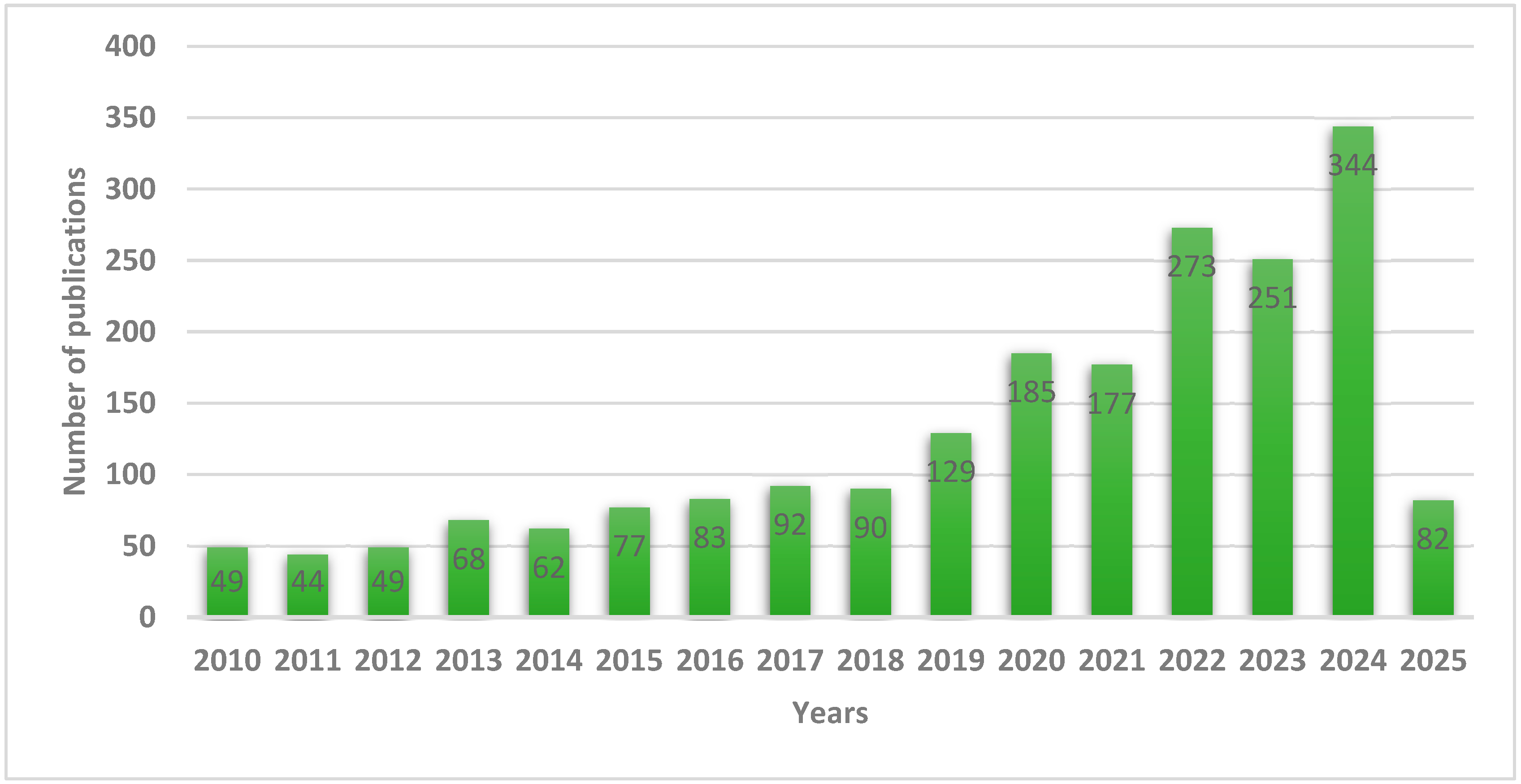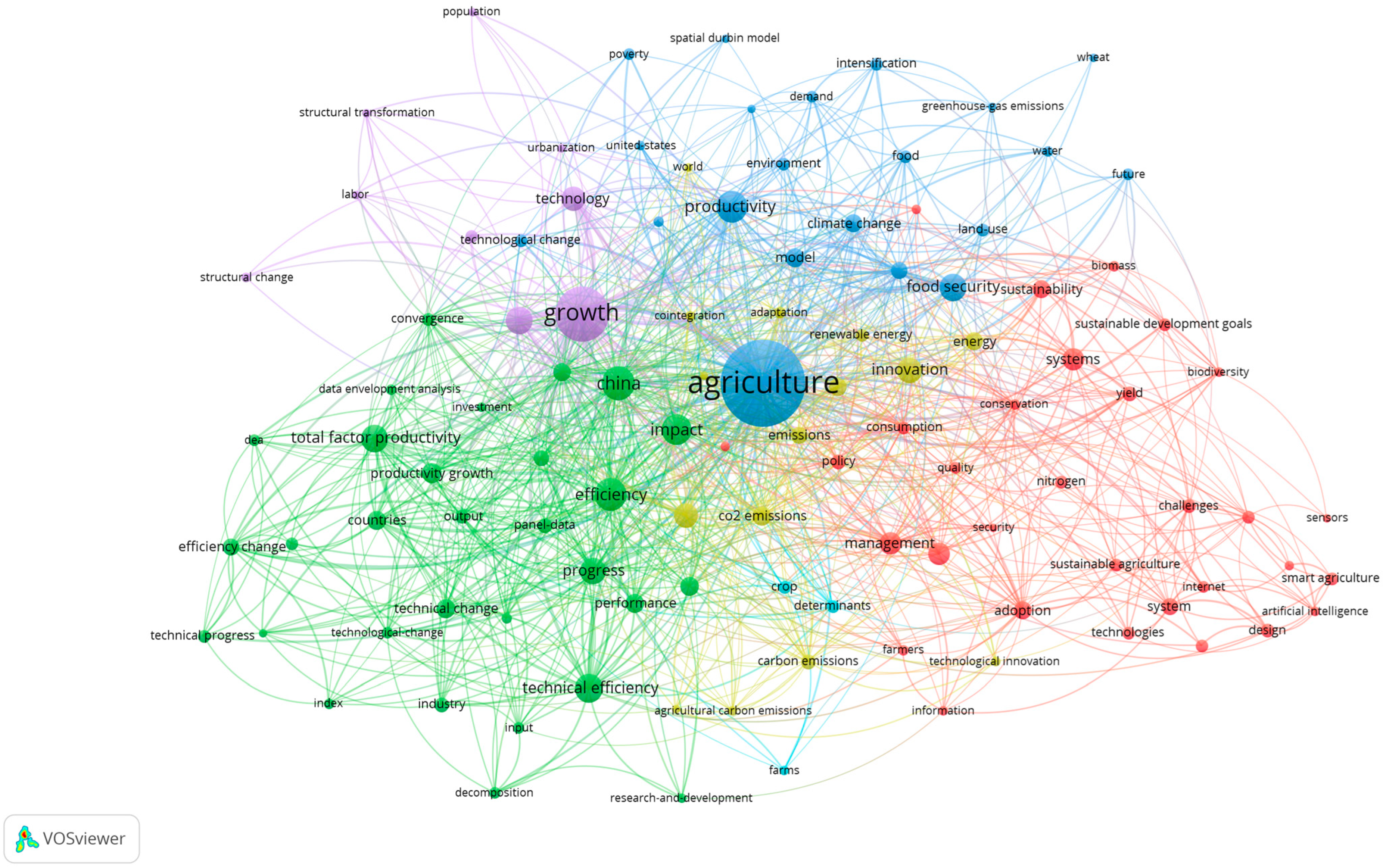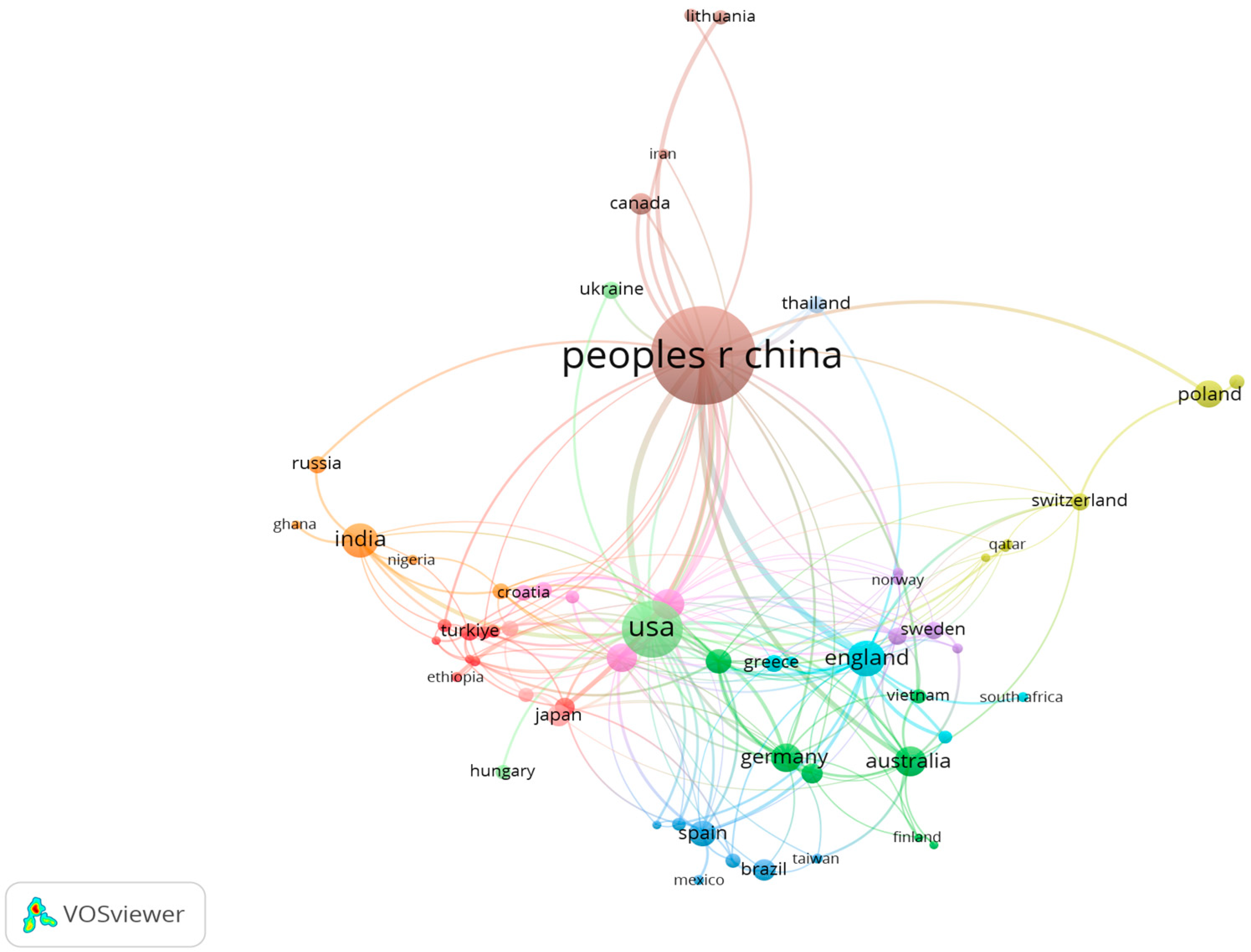Smart Agriculture and Technological Innovation: A Bibliometric Perspective on Digital Transformation and Sustainability
Abstract
1. Introduction
2. Materials and Methods
3. Literature as a Battlefield: Diverging Visions and Hidden Assumptions
3.1. Digital Technologies in Agriculture
3.2. Adjusting Agricultural Practices to Climate Change
3.3. Robotic and Automated Solutions in Agriculture
3.4. Biotechnological Advances and Genetic Innovations in Agriculture
3.5. Research Gaps in Technological Progress in Agriculture
4. Results and Discussion
4.1. Co-Compete Network Analysis of Keywords
4.2. Author Co-Citation Network
4.3. Collaborative Institutional Analysis of Co-Authors
4.4. Country-Level Research Analysis and Collaboration
5. Conclusions
Author Contributions
Funding
Institutional Review Board Statement
Data Availability Statement
Conflicts of Interest
References
- Bechar, A.; Vigneault, C. Agricultural robots for field operations: Concepts and components. Biosyst. Eng. 2016, 149, 94–111. [Google Scholar] [CrossRef]
- Oberti, R.; Marchi, M.; Tirelli, P.; Calcante, A.; Iriti, M.; Tona, E.; Hočevar, M.; Baur, J.; Pfaff, J.; Schütz, C.; et al. Selective spraying of grapevines for disease control using a modular agricultural robot. Biosyst. Eng. 2016, 146, 203–215. [Google Scholar] [CrossRef]
- Shamshiri, R.R.; Kalantari, F.; Ting, K.C.; Thorp, K.R.; Hameed, I.A.; Weltzien, C.; Ahmad, D.; Shad, Z.M. Advances in greenhouse automation and controlled environment agriculture: A transition to plant factories and urban agriculture. Int. J. Agric. Biol. Eng. 2018, 11, 1–22. [Google Scholar] [CrossRef]
- Kim, S.; Lee, M.; Shin, C. IoT-based strawberry disease prediction system for smart farming. Sensors 2018, 18, 4051. [Google Scholar] [CrossRef] [PubMed]
- El Bilali, H.; Strassner, C.; Ben Hassen, T. Sustainable Agri-Food Systems: Environment, Economy, Society, and Policy. Sustainability 2021, 13, 6260. [Google Scholar] [CrossRef]
- Demircioglu, P.; Bogrekci, I.; Durakbasa, N.; Bauer, J. Autonomation, Automation, AI, and Industry-Agriculture 5.0 in Sustainable Agro-Ecological Food Production. In Industrial Engineering in the Industry 4.0 Era; Springer Nature: Cham, Switzerland, 2024; p. 42. [Google Scholar] [CrossRef]
- Manta, A.G.; Doran, N.M.; Bădîrcea, R.M.; Badareu, G.; Ghertescu, C.; Lăpădat, C.V.M. Does Common Agricultural Policy Influence Regional Disparities and Environmental Sustainability in European Union Countries? Agriculture 2024, 14, 2242. [Google Scholar] [CrossRef]
- Zambon, I.; Cecchini, M.; Egidi, G.; Saporito, M.G.; Colantoni, A. Revolution 4.0: Industry vs. Agriculture in a Future Development for SMEs. Processes 2019, 7, 36. [Google Scholar] [CrossRef]
- Ane, T.; Yasmin, S. Agriculture in the Fourth Industrial Revolution. Ann. Bangladesh Agric. 2019, 23, 115–122. [Google Scholar] [CrossRef]
- Bădîrcea, R.M.; Doran, N.M.; Manta, A.G.; Puiu, S.; Meghisan-Toma, G.M.; Doran, M.D. Linking Financial Development to Environmental Performance Index—The Case of Romania. Econ. Res.-Ekon. Istraž. 2022, 36, 2142635. [Google Scholar] [CrossRef]
- Smith, J.C.; Ghosh, A.; Hijmans, R.J. Agricultural intensification was associated with crop diversification in India (1947–2014). PLoS ONE 2019, 14, e0225555. [Google Scholar] [CrossRef]
- John, D.A.; Babu, G.R. Lessons from the aftermaths of Green Revolution on food system and health. Front. Sustain. Food Syst. 2021, 5, 644559. [Google Scholar] [CrossRef] [PubMed]
- Singh, R. Environmental consequences of agricultural development: A case study from the Green Revolution state of Haryana, India. Agric. Ecosyst. Environ. 2000, 82, 97–103. [Google Scholar] [CrossRef]
- Pingali, P.L. Green Revolution: Impacts, limits, and the path ahead. Proc. Natl. Acad. Sci. USA 2012, 109, 12302–12308. [Google Scholar] [CrossRef] [PubMed]
- Taylor, M. Hybrid realities: Making a new Green Revolution for rice in south India. J. Peasant Stud. 2019, 47, 483–502. [Google Scholar] [CrossRef]
- Shiva, V. The Violence of the Green Revolution: Third World Agriculture, Ecology, and Politics; The University Press of Kentucky: Lexington, KY, USA, 2016. [Google Scholar]
- Basso, B.; Antle, J. Digital Agriculture to Design Sustainable Agricultural Systems. Nat. Sustain. 2020, 3, 254–256. [Google Scholar] [CrossRef]
- Narasimha Rao, G.B. Applications of Artificial Intelligence in Precision Agriculture to Ameliorate Production and Distribution. Adv. Mod. Agric. 2024, 4, 2374. [Google Scholar] [CrossRef]
- Hatanaka, M.; Konefal, J. Governing by Data: Metrics and Sustainability in Produce Agriculture. Agric. Hum. Values 2025, 42, 289–301. [Google Scholar] [CrossRef]
- Barbosa Júnior, M.R.; dos Santos, R.G.; Sales, L.A.; de Oliveira, L.P. Advancements in Agricultural Ground Robots for Specialty Crops: An Overview of Innovations, Challenges, and Prospects. Plants 2024, 13, 3372. [Google Scholar] [CrossRef]
- Shahbandeh, M. Smart Agriculture—Statistics & Facts; Statista: Hamburg, Germany, 2025; Available online: https://www.statista.com/topics/4134/smart-agriculture/#topicOverview (accessed on 29 March 2025).
- Nelson, A.R.L.E.; Ravichandran, K.; Antony, U. The impact of the Green Revolution on indigenous crops of India. J. Ethn. Foods 2019, 6, 8. [Google Scholar] [CrossRef]
- Rose, D.C.; Wheeler, R.; Winter, M.; Lobley, M.; Chivers, C.-A. Agriculture 4.0: Making it work for people, production, and the planet. Land Use Policy 2021, 100, 104933. [Google Scholar] [CrossRef]
- Rijswijk, K.; Klerkx, L.; Turner, J.A. Digitalisation in the New Zealand Agricultural Knowledge and Innovation System: Initial understandings and emerging organisational responses to digital agriculture. NJAS—Wagening. J. Life Sci. 2019, 94, 100313. [Google Scholar] [CrossRef]
- FAO. The Future of Food and Agriculture—Alternative Pathways to 2050; Food and Agriculture Organization: Rome, Italy, 2021; Available online: https://openknowledge.fao.org/server/api/core/bitstreams/2c6bd7b4-181e-4117-a90d-32a1bda8b27c/content (accessed on 24 March 2025).
- Giller, K.E.; Delaune, T.; Silva, J.V.; Descheemaeker, K.; van de Ven, G.; Schut, A.G.; van Wijk, M.; Hammond, J.; Hochman, Z.; Taulya, G.; et al. The Future of Farming: Who Will Produce Our Food? Food Secur. 2021, 13, 1231–1246. [Google Scholar] [CrossRef]
- Manta, A.G.; Doran, N.M.; Bădîrcea, R.M.; Badareu, G.; Țăran, A.M. Does the Implementation of a Pigouvian Tax Be Considered an Effective Approach to Address Climate Change Mitigation? Econ. Anal. Policy 2023, 80, 1719–1731. [Google Scholar] [CrossRef]
- Raut, R.; Varma, H.; Mulla, C.; Pawar, V.R. Soil Monitoring, Fertigation, and Irrigation System Using IoT for Agricultural Application. In Intelligent Communication and Computational Technologies; Springer: Berlin/Heidelberg, Germany, 2018; pp. 67–73. [Google Scholar] [CrossRef]
- Prasad, G.D.S.; Vanathi, A.; Devi, B.S.K. A Review on IoT Applications in Smart Agriculture. Recent Dev. Electron. Commun. Syst. 2023, 683–688. [Google Scholar] [CrossRef]
- Fisher, A.C.; Hanemann, W.M.; Roberts, M.J.; Schlenker, W. The Economic Impacts of Climate Change: Evidence from Agricultural Output and Random Fluctuations in Weather: Comment. Am. Econ. Rev. 2012, 102, 3749–3760. [Google Scholar] [CrossRef]
- Klerkx, L.; Rose, D. Dealing with the Game-Changing Technologies of Agriculture 4.0: How Do We Manage Diversity and Responsibility in Food System Transition Pathways? Glob. Food Secur. 2020, 24, 100347. [Google Scholar] [CrossRef]
- Talaviya, T.; Shah, D.; Patel, N.; Yagnik, H.; Shah, M. Implementation of Artificial Intelligence in Agriculture for Optimisation of Irrigation and Application of Pesticides and Herbicides. Artif. Intell. Agric. 2020, 4, 58–73. [Google Scholar] [CrossRef]
- Grainurus. Using Drones in Agriculture; Grainrus: Kursk, Russia, 2024; Available online: https://grainrus.com/en/news/articles/using-drones-in-agriculture/ (accessed on 25 March 2025).
- Shahbandeh, M. Estimated Value of Artificial Intelligence in Agriculture Market from 2023 to 2028; Statista: Hamburg, Germany, 2025; Available online: https://www.statista.com/statistics/1326924/ai-in-agriculture-marketvalue-worldwide/ (accessed on 25 March 2025).
- Herdt, R.W. Biotechnology in Agriculture. Annu. Rev. Environ. Resour. 2006, 31, 265–295. [Google Scholar] [CrossRef]
- Mei, Y.; Wang, Y.; Chen, H.; Sun, Z.S.; Ju, X.D. Recent Progress in CRISPR/Cas9 Technology. J. Genet. Genom. 2016, 43, 63–75. [Google Scholar] [CrossRef]
- Liu, D.; Hu, R.; Palla, K.J.; Tuskan, G.A.; Yang, X. Advances and Perspectives on the Use of CRISPR/Cas9 Systems in Plant Genomics Research. Curr. Opin. Plant Biol. 2016, 30, 70–77. [Google Scholar] [CrossRef]
- Schiml, S.; Fauser, F.; Puchta, H. The CRISPR/Cas System Can Be Used as Nuclease for In Planta Gene Targeting and as Paired Nickases for Directed Mutagenesis in Arabidopsis Resulting in Heritable Progeny. Plant J. 2014, 80, 1139–1150. [Google Scholar] [CrossRef] [PubMed]
- Bassett, A.R.; Kong, L.; Liu, J.-L. A Genome-Wide CRISPR Library for High-Throughput Genetic Screening in Drosophila Cells. J. Genet. Genom. 2015, 42, 301–309. [Google Scholar] [CrossRef] [PubMed]
- Next Starategy Consulting. CRISPR-Cas9 Market Report. 2024. Available online: https://www.nextmsc.com/report/crispr-cas9-market (accessed on 29 March 2025).
- European Commission. Digital Transformation in Agriculture: The Role of AI and IoT; European Commission: Brussels, Belgium, 2022; Available online: https://ec.europa.eu (accessed on 24 March 2025).
- Duguma, A.L.; Bai, X. How the internet of things technology improves agricultural efficiency. Artif. Intell. Rev. 2025, 58, 63. [Google Scholar] [CrossRef]
- Ghertescu, C.; Manta, A.G.; Bădîrcea, R.M.; Manta, L.F. How Does the Digitalization Strategy Affect Bank Efficiency in Industry 4.0? A Bibliometric Analysis. Systems 2024, 12, 492. [Google Scholar] [CrossRef]
- Kirby, A. Exploratory Bibliometrics: Using VOSviewer as a Preliminary Research Tool. Publications 2023, 11, 10. [Google Scholar] [CrossRef]
- Zhang, Y.; Thenkabail, P.S.; Wang, P. A Bibliometric Profile of the Remote Sensing Open Access Journal Published by MDPI between 2009 and 2018. Remote Sens. 2019, 11, 91. [Google Scholar] [CrossRef]
- Manta, A.G.; Gherțescu, C.; Bădîrcea, R.M.; Manta, L.F.; Popescu, J.; Lăpădat, C.V.M. How Does the Interplay Between Banking Performance, Digitalization, and Renewable Energy Consumption Shape Sustainable Development in European Union Countries? Energies 2025, 18, 571. [Google Scholar] [CrossRef]
- Gherțescu, C.; Manta, A.G. Fintech trends and banking digitalization: Insights from a bibliometric analysis. Financ.-Chall. Future 2023, 1, 24–36. [Google Scholar]
- Ball, R.; Dirk, T. Bibliometric Analysis Data, Facts, and Basic Methodological Knowledge: Bibliometrics for Scientists, Science Managers, Research Institutions, and Universities; Research Center Julich: Julich, Germany, 2005; Volume 12. [Google Scholar]
- Zupic, I.; Čater, T. Bibliometric Methods in Management and Organization. Organ. Res. Methods 2015, 18, 429–472. [Google Scholar] [CrossRef]
- Aria, M.; Cuccurullo, C. bibliometrix: An R-tool for comprehensive science mapping analysis. J. Informetr. 2017, 11, 959–975. [Google Scholar] [CrossRef]
- Cao, S.; Huang, H.; Xiao, M.; Yan, L.; Xu, W.; Tang, X.; Luo, X.; Zhao, Q. Research on safety in home care for older adults: A bibliometric analysis. Nurs. Open 2021, 8, 1720–1730. [Google Scholar] [CrossRef] [PubMed]
- Poenaru, M.M.; Manta, A.G.; Gherțescu, C.; Manta, L.G. Shaping the future of horticulture: Innovative technologies, artificial intelligence, and robotic automation through a bibliometric lens. Horticulturae 2025, 11, 449. [Google Scholar] [CrossRef]
- Liu, Y.; Ma, X.; Shu, L.; Hancke, G.P.; Abu-Mahfouz, A.M. From Industry 4.0 to Agriculture 4.0: Current Status, Enabling Technologies, and Research Challenges. IEEE Trans. Ind. Inform. 2021, 17, 4322–4334. [Google Scholar] [CrossRef]
- Bartkowiak, A.; Bartkowiak, P. Technical and Technological Progress in the Context of Sustainable Development of Agriculture in Poland. Procedia Eng. 2017, 182, 66–75. [Google Scholar] [CrossRef]
- Shamshiri, R.R.; Sturm, B.; Weltzien, C.; Fulton, J.; Khosla, R.; Schirrmann, M.; Raut, S.; Basavegowda, D.H.; Yamin, M.; Hameed, I.A. Digitalization of agriculture for sustainable crop production: A use-case review. Front. Environ. Sci. 2024, 12, 1375193. [Google Scholar] [CrossRef]
- Lavanya, G.; Rani, C.; Ganeshkumar, P. An automated low cost IoT based Fertilizer Intimation System for smart agriculture. Sustain. Comput. Inform. Syst. 2019, 21, 39–45. [Google Scholar] [CrossRef]
- Navarro, E.; Costa, N.; Pereira, A. A systematic review of IoT solutions for smart farming. Sensors 2020, 20, 4231. [Google Scholar] [CrossRef] [PubMed]
- da Silveira, F.; Lermen, F.H.; Amaral, F.G. An overview of Agriculture 4.0 development: Systematic review of descriptions, technologies, barriers, advantages, and disadvantages. Comput. Electron. Agric. 2021, 189, 106405. [Google Scholar] [CrossRef]
- Finger, R. Digital innovations for sustainable and resilient agricultural systems. Eur. Rev. Agric. Econ. 2023, 50, 1277–1309. [Google Scholar] [CrossRef]
- Paredes-Gómez, V.; Gutiérrez, A.; Del Blanco, V.; Nafría, D.A. A Methodological Approach for Irrigation Detection in the Frame of Common Agricultural Policy Checks by Monitoring. Agronomy 2020, 10, 867. [Google Scholar] [CrossRef]
- Talavera, J.M.; Tobón, L.E.; Gómez, J.A.; Culman, M.A.; Aranda, J.M.; Parra, D.T.; Quiroz, L.A.; Hoyos, A.; Garreta, L.E. Review of IoT applications in agro-industrial and environmental fields. Comput. Electr. Agric. 2017, 142, 283–297. [Google Scholar] [CrossRef]
- Abiri, R.; Rizan, N.; Balasundram, S.K.; Shahbazi, A.B.; Abdul-Hamid, H. Application of Digital Technologies for Ensuring Agricultural Productivity. Heliyon 2023, 9, e22601. [Google Scholar] [CrossRef] [PubMed]
- Kondratieva, N.B. EU Agricultural Digitalization Decalogue. Her. Russ. Acad. Sci. 2021, 91, 736–742. [Google Scholar] [CrossRef]
- European Commission. The Common Agricultural Policy at a Glance. 2022. Available online: https://agriculture.ec.europa.eu/common-agricultural-policy/cap-overview/cap-glance_en (accessed on 24 March 2025).
- Geng, W.; Liu, L.; Zhao, J.; Kang, X.; Wang, W. Digital technologies adoption and economic benefits in agriculture: A mixed-methods approach. Sustainability 2024, 16, 4431. [Google Scholar] [CrossRef]
- Lamprinopoulou, C.; Renwick, A.; Klerkx, L.; Hermans, F.; Roep, D. Application of an integrated systemic framework for analysing agricultural innovation systems and informing innovation policies: Comparing the Dutch and Scottish agrifood sectors. Agric. Syst. 2014, 129, 40–54. [Google Scholar] [CrossRef]
- Verma, K.K.; Song, X.-P.; Kumari, A.; Jagadesh, M.; Singh, S.K.; Bhatt, R.; Singh, M.; Seth, C.S.; Li, Y.-R. Climate Change Adaptation: Challenges for Agricultural Sustainability. Plant Cell Environ. 2025, 48, 2522–2533. [Google Scholar] [CrossRef] [PubMed]
- European Commission. EU Agricultural Outlook 2023-35: A Transitioning and Resilient EU Farming Sector Will Cope with Challenges and Embrace Opportunities; European Commission: Brussels, Belgium, 2023. [Google Scholar]
- World Bank. Climate-Smart Agriculture; World Bank: Washington, DC, USA, 2023; Available online: https://www.worldbank.org/en/topic/climate-smart-agriculture (accessed on 23 May 2025).
- Kitole, F.A.; Mkuna, E.; Sesabo, J.K. Digitalization and Agricultural Transformation in Developing Countries: Empirical Evidence from Tanzania Agriculture Sector. Smart Agric. Technol. 2024, 7, 100379. [Google Scholar] [CrossRef]
- Lioutas, E.D.; Charatsari, C.; De Rosa, M. Digitalization of Agriculture: A Way to Solve the Food Problem or a Trolley Dilemma? Technol. Soc. 2021, 67, 101744. [Google Scholar] [CrossRef]
- European Commission. Climate Change and Agriculture in the EU—CAP 2023–27; DG AGRI: Brussels, Belgium, 2022; Available online: https://agriculture.ec.europa.eu/common-agricultural-policy/cap-overview/cap-2023-27_en (accessed on 24 March 2025).
- Yang, C.; Ji, X.; Cheng, C.; Liao, S.; Obuobi, B.; Zhang, Y. Digital Economy Empowers Sustainable Agriculture: Implications for Farmers’ Adoption of Ecological Agricultural Technologies. Ecol. Indic. 2024, 159, 111723. [Google Scholar] [CrossRef]
- Yépez-Ponce, D.F.; Salcedo, C.J.; Rosero-Montalvo, P.D.; Sanchis, J. Mobile Robotics in Smart Farming: Current Trends and Applications. Front. Artif. Intell. 2023, 6, 1213330. [Google Scholar] [CrossRef]
- Gebresenbet, G.; Bosona, T.; Patterson, D.; Persson, H.; Fischer, B.; Mandaluniz, N.; Chirici, G.; Zacepins, A.; Komasilovs, V.; Pitulac, T.; et al. A Concept for Application of Integrated Digital Technologies to Enhance Future Smart Agricultural Systems. Smart Agric. Technol. 2023, 5, 100255. [Google Scholar] [CrossRef]
- Sparrow, R.; Howard, M. Robots in Agriculture: Prospects, Impacts, Ethics, and Policy. Precis. Agric. 2021, 22, 818–833. [Google Scholar] [CrossRef]
- Regan, Á. ‘Smart Farming’ in Ireland: A Risk Perception Study with Key Governance Actors. NJAS—Wagening. J. Life Sci. 2019, 90–91, 100292. [Google Scholar] [CrossRef]
- Rotz, S.; Gravely, E.; Mosby, I.; Duncan, E.; Finnis, E.; Horgan, M.; LeBlanc, J.; Martin, R.; Neufeld, H.T.; Nixon, A.; et al. Automated Pastures and the Digital Divide: How Agricultural Technologies Are Shaping Labour and Rural Communities. J. Rural Stud. 2019, 68, 112–122. [Google Scholar] [CrossRef]
- FAO. The State of Food and Agriculture 2022: Leveraging Automation in Agriculture for Transforming Agrifood Systems; FAO: Rome, Italy, 2022. [Google Scholar]
- Koutsos, T.; Menexes, G. Economic, Agronomic, and Environmental Benefits from the Adoption of Precision Agriculture Technologies: A Systematic Review. Int. J. Agric. Environ. Inf. Syst. 2019, 10, 40–56. [Google Scholar] [CrossRef]
- Wolfert, S.; Isakhanyan, G. Sustainable Agriculture by the Internet of Things—A Practitioner’s Approach to Monitor Sustainability Progress. Comput. Electron. Agric. 2022, 200, 107226. [Google Scholar] [CrossRef]
- Kayad, A.; Sozzi, M.; Gatto, S.; Whelan, B.; Sartori, L.; Marinello, F. Ten Years of Corn Yield Dynamics at Field Scale under Digital Agriculture Solutions: A Case Study from North Italy. Comput. Electron. Agric. 2021, 185, 106126. [Google Scholar] [CrossRef]
- Far, S.T.; Rezaei-Moghaddam, K. Impacts of the Precision Agricultural Technologies in Iran: An Analysis Experts’ Perception & Their Determinants. Inf. Process. Agric. 2018, 5, 173–184. [Google Scholar] [CrossRef]
- Ruzzante, S.; Labarta, R.; Bilton, A. Adoption of Agricultural Technology in the Developing World: A Meta-Analysis of the Empirical Literature. World Dev. 2021, 146, 105599. [Google Scholar] [CrossRef]
- Pardey, P.G.; Andrade, R.S.; Hurley, T.M.; Rao, X.; Liebenberg, F.G. Returns to Food and Agricultural R&D Investments in Sub-Saharan Africa, 1975–2014. Food Policy 2016, 65, 1–8. [Google Scholar] [CrossRef]
- Tey, Y.S.; Brindal, M. Factors Influencing the Adoption of Precision Agricultural Technologies: A Review for Policy Implications. Precis. Agric. 2012, 13, 713–730. [Google Scholar] [CrossRef]
- Varga, P.; Plosz, S.; Soos, G.; Hegedus, C. Security Threats and Issues in Automation IoT. In Proceedings of the 2017 IEEE 13th International Workshop on Factory Communication Systems (WFCS), Trondheim, Norway, 31 May–2 June 2017; pp. 1–6. [Google Scholar] [CrossRef]
- Tyagi, S.K.S.; Mukherjee, A.; Pokhrel, S.R.; Hiran, K.K. An Intelligent and Optimal Resource Allocation Approach in Sensor Networks for Smart Agri-IoT. IEEE Sens. J. 2020, 21, 17439–17446. [Google Scholar] [CrossRef]
- Chen, F.; Chen, L.; Yan, Z.; Xu, J.; Feng, L.; He, N.; Guo, M.; Zhao, J.; Chen, Z.; Chen, H.; et al. Recent Advances of CRISPR-Based Genome Editing for Enhancing Staple Crops. Front. Plant Sci. 2024, 15, 1278892. [Google Scholar] [CrossRef] [PubMed]
- Akanmu, A.O.; Asemoloye, M.D.; Marchisio, M.A.; Babalola, O.O. Adoption of CRISPR-Cas for Crop Production: Present Status and Future Prospects. PeerJ 2024, 12, e14899. [Google Scholar] [CrossRef] [PubMed]
- Ansori, A.N.; Antonius, Y.; Susilo, R.J.; Hayaza, S.; Kharisma, V.D.; Parikesit, A.A.; Zainul, R.; Jakhmola, V.; Saklani, T.; Rebezov, M.; et al. Application of CRISPR-Cas9 Genome Editing Technology in Various Fields: A Review. Narra J. 2023, 3, e184. [Google Scholar] [CrossRef]
- Rezaei-Moghaddam, K.; Salehi, S. Agricultural Specialists’ Intention Toward Precision Agriculture Technologies: Integrating Innovation Characteristics to Technology Acceptance Model. Afr. J. Agric. Res. 2010, 5, 1191–1199. [Google Scholar]
- Tasgaonkar, P.P.; Garg, R.D.; Garg, P.K.; Tiwari, R.; Sangamnerkar, K. IoT-Based Smart and Precision Agricultural Applications. In Emerging Trends, Techniques, and Applications in Geospatial Data Science; IGI Global: Hershey, PA, USA, 2023; pp. 113–124. [Google Scholar] [CrossRef]
- Singh, N.K.; Sunitha, N.H.; Saikanth, D.R.K.; Singh, O.; Sreekumar, G.; Singh, B.V. Enhancing Agricultural Production with Digital Technologies: A Review. Int. J. Environ. Clim. Change 2023, 13, 409–422. [Google Scholar] [CrossRef]
- U.S. Department of Agriculture Economic Research Service (USDA ERS). Agricultural Productivity in the United States; USDA: Washington, DC, USA, 2014. Available online: https://www.ers.usda.gov/data-products/agricultural-productivity-in-the-united-states (accessed on 3 April 2025).
- Turnbull, C.; Lillemo, M.; Hvoslef-Eide, T.A.K. Global Regulation of Genetically Modified Crops Amid the Gene Edited Crop Boom—A Review. Front. Plant Sci. 2021, 12, 630396. [Google Scholar] [CrossRef]
- Qaim, M.; Zilberman, D. Yield effects of genetically modified crops in developing countries. Science 2003, 299, 900–902. [Google Scholar] [CrossRef]
- Lombardo, L.; Grando, M.S. Genetically modified plants for nutritionally improved food: A promise kept? Food Rev. Int. 2020, 36, 58–76. [Google Scholar] [CrossRef]
- Lusser, M.; Parisi, C.; Plan, D.; Rodríguez-Cerezo, E. Deployment of new biotechnologies in plant breeding. Nat. Biotechnol. 2012, 30, 231–239. [Google Scholar] [CrossRef] [PubMed]
- Mabaya, E.; Fulton, J.; Simiyu-Wafukho, S.; Nang’ayo, F. Factors influencing adoption of genetically modified crops in Africa. Dev. South. Afr. 2015, 32, 577–591. [Google Scholar] [CrossRef]
- Martin-Laffon, J.; Kuntz, M.; Ricroch, A.E. Worldwide CRISPR patent landscape shows strong geographical biases. Nat. Biotechnol. 2019, 37, 613–620. [Google Scholar] [CrossRef] [PubMed]
- Mathur, V.; Javid, L.; Kulshrestha, S.; Mandal, A.; Reddy, A.A. World Cultivation of Genetically Modified Crops: Opportunities and Risks. In Sustainable Agriculture Reviews; Lichtfouse, E., Ed.; Springer International Publishing: Cham, Switzerland, 2017; pp. 45–87. [Google Scholar]












| Cluster Number | Cluster Color | Keywords |
|---|---|---|
| Cluster 1 | Red | adoption, artificial intelligence, biodiversity, biomass, challenges, classification, conservation, consumption, design, economics, farmers, information, internet, management, mechanization, nitrogen, policy, precision agriculture, quality, security, sensors, smart agriculture, sustainability, sustainable agriculture, sustainable development, sustainable development, systems, technologies, yield |
| Cluster 2 | Green | agricultural productivity, China, convergence, countries, data envelopment analysis, DEA, decomposition, efficiency, efficiency change, energy efficiency, impact, index, industry, input, investment, Malmquist index, output, panel-data, performance, productivity growth, progress, reforms, sector, technical change, technical efficiency, technical progress, technological change, technological-progress, total factor productivity |
| Cluster 3 | Blue | agricultural technology, agriculture, climate change, climate-change, demand, economic growth, environment, food, food security, future, greenhouse-gas emissions, intensification, land-use, model, poverty, productivity, spatial Durbin model, technological change, united-states, water, wheat |
| Cluster 4 | Yellow | adaptation, agricultural carbon emission, carbon emissions, CO2 emissions, cointegration, economic-growth, emissions, energy, energy-consumption, environmental Kuznets curve, impacts, innovation, renewable energy, technological innovation, world |
| Cluster 5 | Purple | growth, labor, population, structural change, structural transformation, technological progress, technology, trade, urbanization |
| Cluster 6 | Cyan | crops, determinants, farms |
| Ranking | Author | Documents | Citations |
|---|---|---|---|
| 1 | Liu, Jianxu | 5 | 110 |
| 2 | Rahman, Sanzidur | 5 | 238 |
| 3 | Shen, Zhiyang | 5 | 196 |
| 4 | Balezentis, Tomas | 3 | 20 |
| 5 | Bravo-ureta, Boris e. | 3 | 61 |
| 6 | Chandio, Abbas Ali | 3 | 130 |
| 7 | Deng, Yue | 3 | 59 |
| 8 | Hertel, Thomas W. | 3 | 101 |
| 9 | Li, Yan | 3 | 27 |
| 10 | Mariyono, Joko | 3 | 59 |
| Ranking | Organization | Documents | Citations |
|---|---|---|---|
| 1 | Chinese Academy of Sciences | 13 | 131 |
| 2 | Beijing Institute of Technology | 10 | 284 |
| 3 | Northwest A&F University | 9 | 155 |
| 4 | Sichuan Agricultural University | 9 | 275 |
| 5 | Huazhong Agricultural University | 8 | 227 |
| 6 | Nanjing Agricultural University | 7 | 40 |
| 7 | China Agricultural University | 6 | 108 |
| 8 | Shandong University of Finance and Economics | 6 | 127 |
| 9 | University of Chinese Academy of Sciences | 6 | 54 |
| 10 | Chiang Mai University | 5 | 110 |
Disclaimer/Publisher’s Note: The statements, opinions and data contained in all publications are solely those of the individual author(s) and contributor(s) and not of MDPI and/or the editor(s). MDPI and/or the editor(s) disclaim responsibility for any injury to people or property resulting from any ideas, methods, instructions or products referred to in the content. |
© 2025 by the authors. Licensee MDPI, Basel, Switzerland. This article is an open access article distributed under the terms and conditions of the Creative Commons Attribution (CC BY) license (https://creativecommons.org/licenses/by/4.0/).
Share and Cite
Gherțescu, C.; Manta, A.G.; Bădîrcea, R.M. Smart Agriculture and Technological Innovation: A Bibliometric Perspective on Digital Transformation and Sustainability. Agriculture 2025, 15, 1388. https://doi.org/10.3390/agriculture15131388
Gherțescu C, Manta AG, Bădîrcea RM. Smart Agriculture and Technological Innovation: A Bibliometric Perspective on Digital Transformation and Sustainability. Agriculture. 2025; 15(13):1388. https://doi.org/10.3390/agriculture15131388
Chicago/Turabian StyleGherțescu, Claudia, Alina Georgiana Manta, and Roxana Maria Bădîrcea. 2025. "Smart Agriculture and Technological Innovation: A Bibliometric Perspective on Digital Transformation and Sustainability" Agriculture 15, no. 13: 1388. https://doi.org/10.3390/agriculture15131388
APA StyleGherțescu, C., Manta, A. G., & Bădîrcea, R. M. (2025). Smart Agriculture and Technological Innovation: A Bibliometric Perspective on Digital Transformation and Sustainability. Agriculture, 15(13), 1388. https://doi.org/10.3390/agriculture15131388







